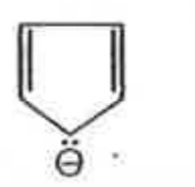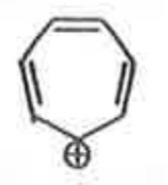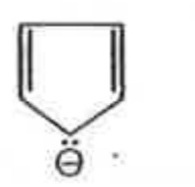An example of a antiaromatic species is




The correct Answer is:D
To determine an example of an antiaromatic species from the given options, we need to follow a systematic approach. Here’s a step-by-step solution:
Step 1: Understand the Criteria for Antiaromaticity
Antiaromatic compounds must satisfy the following conditions:
1. The molecule must be planar.
2. The molecule must be cyclic.
3. There must be conjugation (the presence of overlapping p-orbitals).
4. The molecule must contain 4n pi electrons (where n is a non-negative integer).
Step 2: Analyze Each Option
Let’s evaluate each of the provided options based on the criteria for antiaromaticity.
Option 1:
- Structure: Contains a cyclic structure with conjugation.
- Hybridization: All carbon atoms are sp² hybridized, making it planar.
- Pi Electrons: It has 6 pi electrons (from 3 pi bonds and a lone pair).
- Conclusion: It follows Huckel's rule (4n + 2), so it is aromatic, not antiaromatic.
Option 2:
- Structure: Another cyclic structure with conjugation.
- Hybridization: All carbon atoms are sp² hybridized, making it planar.
- Pi Electrons: It has 6 pi electrons (from 3 pi bonds).
- Conclusion: It follows Huckel's rule (4n + 2), so it is aromatic, not antiaromatic.
Option 3:
- Structure: Contains two rings, cyclic and conjugated.
- Hybridization: All carbon atoms are sp² hybridized, making it planar.
- Pi Electrons: It has 10 pi electrons (from 5 pi bonds).
- Conclusion: It follows Huckel's rule (4n + 2), so it is aromatic, not antiaromatic.
Option 4:
- Structure: A cyclic structure with conjugation.
- Hybridization: All carbon atoms are sp² hybridized, making it planar.
- Pi Electrons: It has 4 pi electrons (from 2 pi bonds).
- Conclusion: It follows the 4n rule (where n=1), so it is antiaromatic.
Step 3: Final Answer
Based on the analysis, the example of an antiaromatic species is Option 4.
---
Antiaromatic compounds must satisfy the following conditions:
1. The molecule must be planar.
2. The molecule must be cyclic.
3. There must be conjugation (the presence of overlapping p-orbitals).
4. The molecule must contain 4n pi electrons (where n is a non-negative integer).
Let’s evaluate each of the provided options based on the criteria for antiaromaticity.
- Structure: Contains a cyclic structure with conjugation.
- Hybridization: All carbon atoms are sp² hybridized, making it planar.
- Pi Electrons: It has 6 pi electrons (from 3 pi bonds and a lone pair).
- Conclusion: It follows Huckel's rule (4n + 2), so it is aromatic, not antiaromatic.
- Structure: Another cyclic structure with conjugation.
- Hybridization: All carbon atoms are sp² hybridized, making it planar.
- Pi Electrons: It has 6 pi electrons (from 3 pi bonds).
- Conclusion: It follows Huckel's rule (4n + 2), so it is aromatic, not antiaromatic.
- Structure: Contains two rings, cyclic and conjugated.
- Hybridization: All carbon atoms are sp² hybridized, making it planar.
- Pi Electrons: It has 10 pi electrons (from 5 pi bonds).
- Conclusion: It follows Huckel's rule (4n + 2), so it is aromatic, not antiaromatic.
- Structure: A cyclic structure with conjugation.
- Hybridization: All carbon atoms are sp² hybridized, making it planar.
- Pi Electrons: It has 4 pi electrons (from 2 pi bonds).
- Conclusion: It follows the 4n rule (where n=1), so it is antiaromatic.
Based on the analysis, the example of an antiaromatic species is Option 4.
Topper's Solved these Questions
Similar Questions
Knowledge Check
Which of the following are pairs of antiaromatic species ?
A B
B C
C D
D
Biological species is a
AExhaustible renewable resourceBInexhaustible natural resourcesCInexhaustible renewable resourceDExhaustible non-renewable resource a
The diamagnetic species is:
View SolutionThe paramagnetic species is
View SolutionAn example of key stone species is :
View SolutionWhat are exotic species? Explain with the help of two examples how the exotic species disturb the native species of an ecosystem.
View SolutionWhich of these is not example of alien species invasion ?
View SolutionThe peramagnetic species is
View Solution
